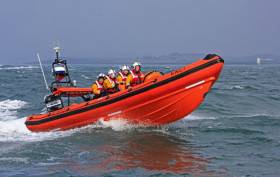Displaying items by tag: Rescuer
#RNLI - Portaferry RNLI’s volunteer crew were paged yesterday afternoon (Saturday 11 August) to go to the aid of two people stranded on Guns Island off Co Down.
The lifeboat launched at 3:20pm in overcast weather with good visibility and a Force 4 south-easterly wind but a rough sea state, and on arrival on scene 20 minutes later it was raining with poor visibility.
Newcastle, Bangor and Portaferry coastguard rescue teams were also in attendance, assisting from the shore.
The RNLI crew approached the scene where they rescued the two people and their dog from the island, where they were stranded after their six-metre punt got into difficultly and was destroyed on nearby rocks.
The casualties were taken to Ballyhornan Beach where they were transferred to the care of the coastguard rescue teams on shore.
Elsewhere, Clifden RNLI added to their busy August with a callout to a yacht with engine trouble both of Slyne Head on Friday afternoon (10 August).
A light Force 2 north-westerly wind made the yacht’s passage to Clifden slow going under sail alone. The Clifden lifeboat crew established a tow to Clifden Bay, which took over an hour, and the D-class lifeboat aided in mooring the yacht.
“Once on the mooring, a rope could be observed caught underneath the yachts hull and an attempt was made to release it. This proved unsuccessful but explained how the yacht had lost mechanical propulsion,” said Clifden RNLI coxswain David Barry.





























































